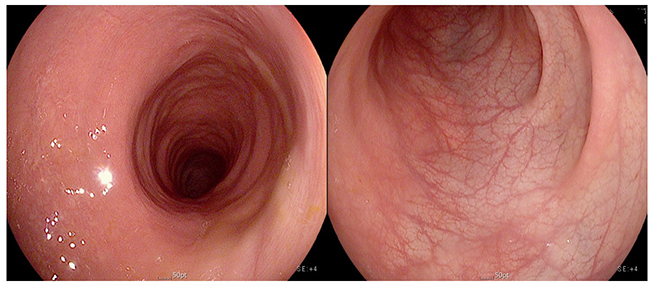Korean J Gastroenterol.
2019 Aug;74(2):115-118. 10.4166/kjg.2019.74.2.115.
Ischemic Colitis Associated with Rhabdomyolysis and Heat Stroke after an Intense Exercise in Young Adult
- Affiliations
-
- 1Department of Internal Medicine, Wonkwang University Sanbon Hospital, Gunpo, Korea.
- 2Department of Emergent Medicine, Wonkwang University Sanbon Hospital, Gunpo, Korea.
- 3Department of Radiology, Wonkwang University Sanbon Hospital, Gunpo, Korea.
- 4Department of Internal Medicine, SMG-SNU Boramae Medical Center, Seoul, Korea.
- 5Division of Sports Science, Wonkwang University, Iksan, Korea.
- 6Wonkwang Digestive Disease Research Institute, Wonkwang University School of Medicine, Iksan, Korea. medcsc@wonkwang.ac.kr
- 7Good Breath Clinic, Gunpo, Korea.
- KMID: 2455775
- DOI: http://doi.org/10.4166/kjg.2019.74.2.115
Abstract
- Ischemic colitis primarily affects the elderly with underlying disease, but it rarely occurs in young adults with risk factors, such as coagulopathy or vascular disorder. Moreover, it is extremely rare in the very young without risk factors. This paper presents a patient with ischemic colitis associated with heat stroke and rhabdomyolysis after intense exercise under high-temperature conditions. A 20-year-old man presented with mental deterioration after a vigorous soccer game for more than 30 minutes in sweltering weather. He also presented with hematochezia with abdominal pain. The laboratory tests revealed the following: AST 515 U/L, ALT 269 U/L, creatine kinase 23,181 U/L, BUN 29.1 mg/dL, creatinine 1.55 mg/dL, and red blood cell >50/high-power field in urine analysis. Sigmoidoscopy showed ischemic changes at the rectum and rectosigmoid junction. A diagnosis of ischemic colitis and rhabdomyolysis was made, and the patient recovered after conservative and fluid therapy. This case showed that a diagnosis of ischemic colitis should be considered in patients who present with abdominal pain and bloody diarrhea after intense exercise, and appropriate treatment should be initiated immediately.
Keyword
MeSH Terms
Figure
Reference
-
1. Brandt LJ, Feuerstadt P, Longstreth GF, Boley SJ. American College of Gastroenterology. ACG clinical guideline: epidemiology, risk factors, patterns of presentation, diagnosis, and management of colon ischemia (CI). Am J Gastroenterol. 2015; 110:18–44.
Article2. Yoon BW, Park JS, Woo YS, et al. Severe ischemic colitis from gastric ulcer bleeding-induced shock in patient with end stage renal disease receiving hemodialysis. Korean J Helicobacter Up Gastrointest Res. 2016; 16:165–168.
Article3. Sanchez LD, Tracy JA, Berkoff D, Pedrosa I. Ischemic colitis in marathon runners: a case-based review. J Emerg Med. 2006; 30:321–326.
Article4. Moses FM. Exercise-associated intestinal ischemia. Curr Sports Med Rep. 2005; 4:91–95.
Article5. Choi SJ, Kim YS, Chae JR, et al. Effects of ranitidine for exercise induced gastric mucosal changes and bleeding. World J Gastroenterol. 2006; 12:2579–2583.
Article6. Kimura T, Shinji A, Horiuchi A, et al. Clinical characteristics of young-onset ischemic colitis. Dig Dis Sci. 2012; 57:1652–1659.
Article7. Brouns F, Beckers E. Is the gut an athletic organ? Digestion, absorption and exercise. Sports Med. 1993; 15:242–257.8. Cohen DC, Winstanley A, Engledow A, Windsor AC, Skipworth JR. Marathon-induced ischemic colitis: why running is not always good for you. Am J Emerg Med. 2009; 27:255.e5–255.e7.
Article9. Rowell LB. Human cardiovascular adjustments to exercise and thermal stress. Physiol Rev. 1974; 54:75–159.
Article10. Clausen JP. Effect of physical training on cardiovascular adjustments to exercise in man. Physiol Rev. 1977; 57:779–815.
Article11. Qamar MI, Read AE. Effects of exercise on mesenteric blood flow in man. Gut. 1987; 28:583–587.
Article12. Perko MJ, Nielsen HB, Skak C, Clemmesen JO, Schroeder TV, Secher NH. Mesenteric, coeliac and splanchnic blood flow in humans during exercise. J Physiol. 1998; 513(Pt 3):907–913.
Article13. Lucas W, Schroy PC 3rd. Reversible ischemic colitis in a high endurance athlete. Am J Gastroenterol. 1998; 93:2231–2234.
Article14. Moses FM. The effect of exercise on the gastrointestinal tract. Sports Med. 1990; 9:159–172.15. de Oliveira EP, Burini RC. The impact of physical exercise on the gastrointestinal tract. Curr Opin Clin Nutr Metab Care. 2009; 12:533–538.
Article16. Peters HP, van Schelven FW, Verstappen PA, et al. Gastrointestinal problems as a function of carbohydrate supplements and mode of exercise. Med Sci Sports Exerc. 1993; 25:1211–1224.
Article17. Choi SC, Choi SJ, Kim JA, et al. The role of gastrointestinal endoscopy in long-distance runners with gastrointestinal symptoms. Eur J Gastroenterol Hepatol. 2001; 13:1089–1094.
Article
- Full Text Links
- Actions
-
Cited
- CITED
-
- Close
- Share
- Similar articles
-
- Exertional heat stroke-related rhabdomyolysis recurring twice in a 12-year-old boy athlete
- Acute Renal Failure and Electrolyte Imbalance in Patients with Exertional Rhabdomyolysis
- A Case of Oral-contraceptive Related Ischemic Colitis in Young Woman
- Two Childhood Cases of Heat Stroke with Rhabdomyolysis and Multiorgan Failure
- A Case Rhabdomyolysis by Rare Causes: After Consumption of Common Doses of Acetaminophen and Sauna




